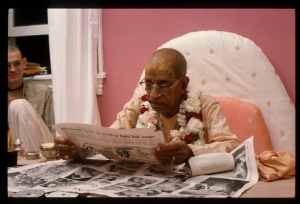SB 10.13.54

A.C. Bhaktivedanta Swami Prabhupada
TEXT 54
- satya-jñānānantānanda-
- mātraika-rasa-mūrtayaḥ
- aspṛṣṭa-bhūri-māhātmyā
- api hy upaniṣad-dṛśām
SYNONYMS
satya — eternal; jñāna — having full knowledge; ananta — unlimited; ānanda — fully blissful; mātra — only; eka-rasa — always existing; mūrtayaḥ — forms; aspṛṣṭa-bhūri-māhātmyāḥ — whose great glory is not touched; api — even; hi — because; upaniṣat-dṛśām — by those jñānīs who are engaged in studying the Upaniṣads.
TRANSLATION
The viṣṇu-mūrtis all had eternal, unlimited forms, full of knowledge and bliss and existing beyond the influence of time. Their great glory was not even to be touched by the jñānīs engaged in studying the Upaniṣads.
PURPORT
Mere śāstra jñāna, or knowledge in the Vedas, does not help anyone understand the Personality of Godhead. Only one who is favored or shown mercy by the Lord can understand Him. This is also explained in the Upaniṣads (Muṇḍaka Upaniṣad 3.2.3):
- nāyam ātmā pravacanena labhyo
- na medhasā na bahunā śrutena
- yam evaiṣa vṛṇute tena labhyas
- tasyaiṣa ātmā vivṛṇute tanuṁ svām
"The Supreme Lord is not obtained by expert explanations, by vast intelligence, or even by much hearing. He is obtained only by one whom He Himself chooses. To such a person, He manifests His own form."
One description given of Brahman is satyaṁ brahma, ānanda-rūpam: "Brahman is the Absolute Truth and complete ānanda, or bliss." The forms of Viṣṇu, the Supreme Brahman, were one, but They were manifested differently. The followers of the Upaniṣads, however, cannot understand the varieties manifested by Brahman. This proves that Brahman and Paramātmā can actually he understood only through devotion, as confirmed by the Lord Himself in Śrīmad-Bhāgavatam: bhaktyāham ekayā grāhyaḥ (SB 11.14.21). To establish that Brahman indeed has transcendental form, Śrīla Viśvanātha Cakravartī Ṭhākura gives various quotations from the śāstras. In the Śvetāśvatara Upaniṣad (3.8), the Supreme is described as āditya-varṇaṁ tamasaḥ parastāt, "He whose self-manifest form is luminous like the sun and transcendental to the darkness of ignorance." Ānanda-mātram ajaraṁ purāṇam ekaṁ santaṁ bahudhā dṛśyamānam: "The Supreme is blissful, with no tinge of unhappiness. Although He is the oldest, He never ages, and although one, He is experienced in different forms." Sarve nityāḥ śāśvatāś ca dehās tasya parātmanaḥ: "All the forms of that Supreme Person are eternal." (Mahā-varāha Purāṇa) The Supreme Person has a form, with hands and legs and other personal features, but His hands and legs are not material. Bhaktas know that the form of Kṛṣṇa, or Brahman, is not at all material. Rather, Brahman has a transcendental form, and when one is absorbed in it, being fully developed in bhakti, one can understand Him (premāñjana-cchurita-bhakti-vilocanena (BS 5.38)). The Māyāvādīs, however, cannot understand this transcendental form, for they think that it is material.
Transcendental forms of the Supreme Personality of Godhead in His person are so great that the impersonal followers of the Upaniṣads cannot reach the platform of knowledge to understand them. Particularly, the transcendental forms of the Lord are beyond the reach of the impersonalists, who can only understand, through the studies of the Upaniṣads, that the Absolute Truth is not matter and that the Absolute Truth is not materially restricted by limited potency.
Yet although Kṛṣṇa cannot be seen through the Upaniṣads, in some places it is said that Kṛṣṇa can in fact be known in this way. Aupaniṣadaṁ puruṣam: "He is known by the Upaniṣads." This means that when one is purified by Vedic knowledge, one is then allowed to enter into devotional understanding (mad-bhaktiṁ labhate parām (BG 18.54)).
- tac chraddadhānā munayo
- jñāna-vairagya-yuktayā
- paśyanty ātmani cātmānaṁ
- bhaktyā śruta-gṛhītayā
"The seriously inquisitive student or sage, well equipped with knowledge and detachment, realizes that Absolute Truth by rendering devotional service in terms of what he has heard from the Vedānta-śruti." (SB 1.2.12) The word śruta-gṛhītayā refers to Vedānta knowledge, not sentimentality. Śruta-gṛhīta is sound knowledge.
Lord Viṣṇu, Brahmā thus realized, is the reservoir of all truth, knowledge and bliss. He is the combination of these three transcendental features, and He is the object of worship for the followers of the Upaniṣads. Brahmā realized that all the different forms of cows, boys and calves transformed into Viṣṇu forms were not transformed by mysticism of the type that a yogī or demigod can display by specific powers invested in him. The cows, calves and boys transformed into viṣṇu-mūrtis, or Viṣṇu forms, were not displays of viṣṇu-māyā, or Viṣṇu energy, but were Viṣṇu Himself. The respective qualifications of Viṣṇu and viṣṇu-māyā are just like those of fire and heat. In heat there is the qualification of fire, namely warmth; and yet heat is not fire. The manifestation of the Viṣṇu forms of the boys, cows and calves was not like the heat, but rather like the fire—they were all actually Viṣṇu. Factually, the qualification of Viṣṇu is full truth, full knowledge and full bliss. Another example may be given with material objects, which may be reflected in many, many forms. For example, the sun is reflected in many waterpots, but the reflections of the sun in many pots are not actually the sun. There is no actual heat and light from the sun in the pot, although it appears as the sun. But each and every one of the forms Kṛṣṇa assumed was fully Viṣṇu.
We should discuss Śrīmad-Bhāgavatam daily as much as possible, and then everything will be clarified, for Bhāgavatam is the essence of all Vedic literature (nigama-kalpa-taror galitaṁ phalam (SB 1.1.3)). It was written by Vyāsadeva (mahā-muni-kṛte) when he was self-realized. Thus the more we read Śrīmad-Bhāgavatam, the more its knowledge becomes clear. Each and every verse is transcendental.